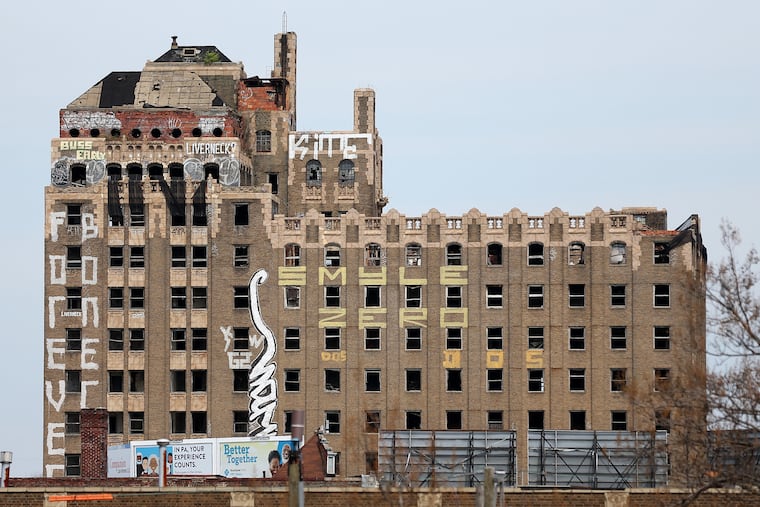Fate of North Philly graffiti-adorned building still in limbo as hotel development forges ahead
Designers are balancing the wishes of Marriott, which will open a hotel in the building, and historical commission requirements.

In the end, “Boner 4Ever” will likely not be forever in North Philadelphia.
Restoration began last week to turn the long-blighted Beury Building at Broad Street and Erie Avenue into a Marriott Hotel, a development that’s viewed as a key part of an economic revitalization of North Broad Street. But for now, the building’s best-known signpost — two massive graffiti columns that read “Boner 4Ever” and “Forever Boner” on two sides of the 14-story tower — won’t be touched.
When plans were announced more than two years ago, the building’s owner vowed to pay tribute to the famous graffiti. Those deliberations remain ongoing as project designers juggle the standards of a Fortune 500 corporation and the requirements of federal and local historical commissions.
“We have Marriott’s standards we are dancing with, but with the art, we want to bring in the energy of the community,” said Floss Barber, the interior designer on the project.
After debate first erupted over the fate of the unmissable tags in 2020, Barber said a representative for the graffiti artists reached out, and project backers later met with men behind the two distinct pen names, “Boner” and “Forever,” to discuss incorporating their signatures into the final design.
“It felt very clandestine in the conference room,” Barber said. “We didn’t really get their [real] names.”
But Barber said developers have instead chosen to not focus their homage on the duo, but rather incorporate other artists whose graffiti work adorns the decaying Art Deco building-turned-popular graffiti canvas.
Design renderings include “graffiti walls” where existing tags could be preserved within the future hotel — including one homage to the bubble-lettered “B,” associated with the street artist known as “Boner.” Barber said there are other tags and artists they are working to identify, as well.
Stuart Rosenberg, the architect for the project, said that current restoration work is limited to getting the structure in safe shape, which includes rebuilding a collapsed roof, securing elevator shafts, and other safety measures in the windowless tower.
“It’s a brick and limestone and terra cotta masonry structure, and there’s been virtually no maintenance on the building since it was erected,” Rosenberg said.
The Beury Building takes its name from Charles Beury, the first president of the National Bank of North Philadelphia, which opened in 1927 during a golden age for investment along Broad Street.
But the structure has sat abandoned for decades on North Broad — a monolithic symbol of the larger economic plight that has ravaged the surrounding area. Critics have complained that it attracts blight, and some neighborhood civic leaders are ready to say goodbye to the graffitied ruin.
“Graffiti is not art to us — especially something that is derogatory,” said Cynthia Barnes, co-director of the Nicetown Tioga Improvement Team and a lifelong resident in the area. “That is not the voice of the people.”
Philadelphia-based Shift Capital acquired the hulking Art Deco tower in 2012, with hopes of jump-starting a commercial investment boom in the heart of North Philly. Initial plans to erect a mixed-use apartment and business building were later traded with a plan for a boutique Marriott.
Barnes said the owner and contractors have been in steady communication with neighborhood groups, and while it’s been a bumpy process at times, she’s excited for the new development.
After pandemic-related delays, Rosenberg said work will steadily continue on the building now over the next two years.
It remains unclear when the curtain could come down on the graffiti columns, but Rosenberg acknowledged that restoring the exterior walls of the building would require it at some point.
Some architectural conservationists have argued for fully preserving the massive tag as both a cultural and historical homage to the neighborhood. Others are focused on the Beury’s rebirth, sans spray paint.
“I would say that most preservationists, including me, believe that graffiti disfigures and detracts from the beauty of historic architecture and that its removal during the restoration process would be a good idea,” said Paul Steinke, executive director of the Preservation Alliance of Greater Philadelphia.
But the government says the decision remains up to the developers.
The Philadelphia Historical Commission is reviewing design plans with an eye toward preserving “character-defining features,” as it does with all historic structures, according to spokesperson Bruce Bohri.
While the graffiti is “certainly part of the building’s character these days,” Bohri noted, the tag was made years after the city granted the building historic designation 1985 — which means it’s not in the city’s purview.
“The Historical Commission cannot use its regulatory authority to compel an owner to retain a non-historic element of a building,” Bohri said.